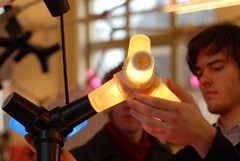-
-

- Scape, Minor Design Studio, Hyperbody & ID-StudioLab, Fall Semester 2009
-
- EDUCATION
- Minor
- Code
- BK-Mi-124-11
- Course Title
- Interactive Environments
- Faculties involved
- BK / department Hyperbody & IO / department ID-StudioLab & EEMCS / department Man-Machine Interaction
- Credit points
- 30
- Coordinator
- Aadjan van der Helm [IO / ID-StudioLab]
- Academic Chair involved
- Kas Oosterhuis [BK / Hyperbody] & David Keyson [IO / ID-StudioLab] & Catholijn Jonker [EEMCS / Man-Machine Interaction]
- Intended for
- The Minor will be offered to TU Delft Bachelor students from all faculties
- Maximum number of participants
- 30
- Location
- Science Centre Delft (Mijnbouwstraat on the TU campus)
-
-
For the latest infromation on this minor please visit http://studiolab.ide.tudelft.nl/ie/
Introduction Minor
The Interactive Environments Minor is a shared initiative by the faculty of Architecture, Industrial Design, and Electrical Engineering, Mathematics and Computer Science. The Interactive Environments minor is a six months multidisciplinary course involving Hyperbody (A), ID-StudioLab (ID) and Man-Machine Interaction (EEMCS). The minor is hosted by the Science Centre of the TU Delft in a dedicated laboratory space.The Interactive Environments minor offers you an exciting, five-month ride through interactive architecture: you will learn new technologies at every scale, interact with exciting guest speakers and take part in a visionary and challenging course-length project. You will be full-time engaded in exploring the possibilities of multimodal, whole body interaction, working with new design methods, input devices, cybernetics, dynamic actuators, high-tech materials and rapid prototyping tools. You will apply your knowledge and skills in a real-life project, leading to creation of a full-scale working prototype of a large interactive structure.
The course aims at bringing together experimental architecture, form-prototyping technologies, human-computer interaction knowledge and the techniques of sketching with technology, to provide ambitious, multidisciplinary students with the conceptual and practical tools for mastering the newly emerging phenomenon: interactive environments.
The course structure of the Interactive Environments Minor is built around a group project assignment of an interactive social space, built up from autonomously operating smart building components. The students are assigned to design, fabricate and build a fully operational complex spatial interactive installation. All courses within the minor are geared towards supporting this goal in a variety of ways. The design assignment includes the design of interaction scenarios, and the integration of its embedded computing technologies.Minor Exit Qualifications
After successfully completing this course each student will learn to:
- formulate an ambitious yet feasible spatial design vision, project planning and strategy, accordingly plan a systematic approach to the design project characterized by the use of theories, models and coherent interpretations, while having a critical attitude, and insight into the nature of most recent science and technology
- recognize and apply specific technical knowledge and skills required to complete the main assignment
- integrate and employ individual, major-specific skills and knowledge in a product-oriented group work environment
- develop and apply task-oriented group working skills and organization strategies, prove competence in cooperating and communicating; be able to not only adequately interact, but also have a sense of responsibility, and leadership
- develop and apply skills in using images and written and spoken word in order to convey the essence of a design to others
- learn practical skills for real-life project development
- estimate impact of proposed design on culture, society and environment
- deploy and user-test preliminary prototypes and the final design product
- gather knowledge and insight from developing working prototypes, being both building components and industrial products
- evaluate and defend the final design product
Minor Coherence / Goal
The main filed of study in Interactive Environments Minor is multi-user interaction with smart spatial environments.
The course structure is built around a group project assignment of an interactive social space, consisting of autonomously operating intelligent building components and smart products.
The group project provides a framework to which all course modules and individual student assignments fit in. This delivers a setup balanced between education and practice, geared towards helping students in acquiring practical skills and knowledge needed for building, testing and evaluating experimental interactive complex spatial environmentsMinor Content
In the design course students are encouraged to formulate challenging design visions. Those visions are subsequently realized and tested in form of robust, fully operational and full-scale prototypes.
Students from different faculties work together in multidisciplinary groups that design, produce, and deploy unprecedented interactive spatial installations
They receive professional guidance from specialists from all involved fields and direct, hands-on access to cutting-edge technologies provided by affiliated commercial partners.
In process of building the prototypes they acquire practical knowledge needed to undertake this challenge. This knowledge ranges from creative design strategies through project management skills to technical and technological means of physically constructing a complex interactive structure.
 Facebook/
Facebook/
 Twitter/
Twitter/
 RSS
RSS
